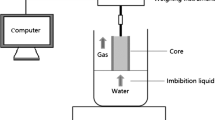Abstract
Wellbore instability in shale results in annual expenditure for petroleum industry especially for shale gas/oil development. Osmotic pressure is one of the most significant effects, which affect wellbore stability during drilling in shale formation using water-based mud. Until now, methods to calculate osmotic were only undertaken in the pre-drilling or post-drilling phase. This paper presents a new developed method to estimate shale osmotic pressure using an spontaneous potential (SP) log, which makes it possible to calculate osmotic pressure during drilling. The relationship between shale osmotic pressure and SP log was investigated. It was found that osmotic pressure and SP value both depend on the shale cation exchange capacity, which was used to bridge the SP log and osmotic pressure. An empirical equation relating the SP value and osmotic pressure was developed, which can compute osmotic pressure using the SP value. Moreover, the depth-dependent earth temperature was considered in the osmotic pressure calculation. A case study was undertaken using the SP log of a wellbore section located in Shengli Oil Field, China.










Similar content being viewed by others
Abbreviations
- p π :
-
Osmotic pressure (MPa)
- I m :
-
Membrane efficiency (–)
- R :
-
Universal gas constant = 8.314 kg m2/(s2 g mole K)
- V :
-
Partial molar volume of water = 1.8 × 10−5 m3/g mole
- T :
-
Temperature (K)
- A mud :
-
Mud water activity (–)
- A shale :
-
Shale water activity (–)
- A mf :
-
Mud filtrate water activity (–)
- A w :
-
Original formation water activity (–)
- E d :
-
Diffusion potential (mV)
- E da :
-
Diffusion–adsorption potential (mV)
- C mf :
-
Solution mass concentration in invaded zone (g/l)
- C w :
-
Solution mass concentration in virgin zone (g/l)
- K d :
-
Diffusion potential (mV/K)
- R mf :
-
Mud filtrate electrical resistivity (Ω m)
- R w :
-
Formation water electrical resistivity (Ω m)
- K da :
-
Diffusion–adsorption coefficient (mV/K)
- F :
-
Osmotic coefficient (MPa/K)
- F S :
-
Standard osmotic coefficient (MPa/K)
- K S :
-
Standard potential coefficient (mV/K)
- R pp :
-
Pressure/potential ratio (–)
- R C :
-
C w/C mf ratio (–)
- R R :
-
R mf/R w ratio (–)
- R A :
-
A mf/A w ratio (–)
- Q v :
-
Volume cation exchange capacity (meq/cm3)
- r m :
-
Resistivity in mud
- r xo :
-
Resistivity invaded zone
- r t :
-
Resistivity in virgin zone
- r sh :
-
Resistivity in shale
References
AL-Bazali TM (2005) Experimental study of the membrane behavior of shale during interaction with water-based and oil based muds. Doctor dissertation at University of Texas at Austin
Chen G, Chenevert ME, Sharma MM, Yu M (2001) Poroelasticchemical, and thermal effects on wellbore stability in shales. Presented at the 38th U.S. Symposium on Rock Mechanics (USRMS), 7–10 July 2001, Washington, DC
Chen G, Chenevert ME, Sharma MM, Yu M (2003) A study of wellbore stability in shales including poroelastic chemical, and thermal effects. J Petrol Sci Eng 38(2003):167–176
Chenevert ME (1970) Shale alteration by water adsorption. J Petrol Technol 22(9):1141–1148
Doll HG (1948) The S.P. Log: theoretical analysis and principles of interpretation. Trans AIME 179:146–185
Fritz SJ, Marine IW (1983) Experimental support for a predictive osmotic model of clay membranes. Geochim Cosmochim Acta 47(8):1515–1522
Ghassemi A, Diek A (2002) Porothermoelasticity for swelling shales. J Petrol Sci Eng 34(2002):123–135
Ghassemi A, Diek A (2003) Linear chemo-poroelasticity for swelling shales: theory and application. J Petrol Sci Eng 38(2003):199–212
Hong Y (1998) Logging principles and comprehensive interpretation. China University of Petroleum Press, Beijing. ISBN 978-7-5636-0270-4
Hou Z, Pusch G, Somerville J, Hutcheon R (2004) Hydro-mechanical and chemo-mechanical effects on wellbore stability in shale. In: Proceedings DGMK Conference, Celle, 29–30 April 2004. DGMK, Hamburg
Jhoao VC, Sergio OO, Zuly CC, Néstor-F S (2009) Assembly of a methodology for determination of membrane efficiency in preserved shales. CTF 3(5):67
Kang J-B, Shackelford (2009) Clay membrane testing using a flexible-wall cell under closed-system boundary conditions. Appl Clay Sci 44(2009):43–58
Kang J-B, Shackelford CD (2010) Membrane behavior of compacted clay liners. J Geotech Geoenviron Eng 136(10):1368
Katsube TJ (2000) Shale permeability and pore-structure evolution characteristics. Current research 2000-E15, Geological Survey of Canada, Ottawa
Malusis MA, Shackelford CD, Olsen HW (2001) A laboratory apparatus to measure chemico-osmotic efficiency coefficients for clay soils. Geotech Test J GTJODJ 24(3):229–242
Marshall CE (1964) The physical chemistry and mineralogy of solids. Wiley, New York, p 1
Neuzil CE, Provost AM (2009) Recent experimental data may point to a greater role for osmotic pressure in the subsurface. Water Resour Res 45:W03410
Author information
Authors and Affiliations
Corresponding author
Rights and permissions
About this article
Cite this article
Luo, X., Were, P., Hou, Z. et al. Determination of shale osmotic pressure using spontaneous potential log. Environ Earth Sci 76, 19 (2017). https://doi.org/10.1007/s12665-016-6340-8
Received:
Accepted:
Published:
DOI: https://doi.org/10.1007/s12665-016-6340-8




